The age-old battle of the campsite. Which is better? A tent or a campervan? Die-hard camping fans will always claim that the tent is the ultimate outdoor experience. Lightweight, easy to put up and just as easy to take down, tents have been the best way of having a cheap holiday for generations.
But...
Anyone who has ever tried to pitch a tent in a force eight gale and torrential rain will know just how soul destroying it can be. No matter how good a tent is, a leak will eventually ensure that your bedding, change of clothes and even your socks are as damp as the rest of you. Unless you're going for a family-sized construction with separate rooms for the kids and a communal area in the middle, there's not much privacy either and they can be very cramped. And if it suddenly turns cold outside, it's going to turn cold inside too.
Yes, camping has the advantage of being a cheap way of spending a couple of weeks away from your normal environment, and quite often site camping plots are considerably cheaper than a campervan plot. So what advantages does a campervan have?
The obvious...
The first and most obvious advantage of a campervan is that there's no need to spend an hour in the rain trying to find your tent pegs. With a campervan you just park up, pop the top (if you're lucky enough to have a pop-top van) and get the kettle on. When you're ready to move on all you have to do is take the top down, get in the driving seat and you're off. Pitching and striking takes all of 30 seconds, even in a force eight gale.
Cooking on a camping stove may be some people's idea of fun, but the campervan has the advantage there too. A decent sized stove can greatly increase the variety of meals you can cook, especially if you have kids along too. You're not restricted to bacon and eggs or stew in a tin - and with plenty of storage space you can take your provisions with you instead of searching for a local shop late in the evening in the vain hope that they haven't run out of bread.
And then there's the leaks. In a campervan (unless the seal on the pop-top's starting to crack!) you don't get that infuriating and unexpected drip down the back of the neck at three in the morning. Your clothes and your bedding stay dry and you can even leave muddy boots outside under the van so you don't trample dirt inside.
The not so obvious...
Sometimes trying to find a campsite late in the evening can be a tough job for even the most organised of camping enthusiasts. With a campervan a quiet lay-by can serve as a makeshift stop, as long as you don't mind the occasional bit of traffic noise. Campervans give you a lot more freedom in where you choose to stop for the night, but do check any local by-laws and restrictions before you plot up (they can often be found on notice boards in larger lay-bys).
While camping invariably means blow up mattresses that suddenly develop a slow puncture in the middle of the night, with a campervan you have the luxury of a proper mattress and all the bedding you could want. Warm, cosy and comfortable, a campervan will easily sleep four and some will even sleep six (at a push).
If you're talking practicalities, then the campervan wins every time. Stuffed full of everything you need to just get up and go on a whim, there's a lot less organisation required to go campervaning. But for the real die-hards you can always put a tent in the van as well, just in case you fancy a night under canvas!
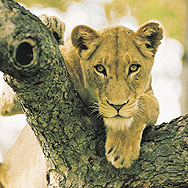
Safari Destinations Guide lets you see two of the most famous reserves in Kenya, the world renown Masai Mara with its superb wildlife and Lake Nakuru, famous for its huge flock of flamingos.
The joy of camping in Kenya is that it allows you to get off the beaten track and experience the wilderness. In the Masai Mara you will stay at a semi-permanent camp where everything is ready when you arrive. At Nakuru you stay at a local hotel because there are no camping facilities in the park.
The Swahili word "safari" means journey and over the years Kenya has become one of the most popular destinations for such a trip. Justifiably so, boasting diverse and beautiful landscapes and the most diverse collection of wild animals on the continent. Situated on Africa’s east coast, Kenya straddles the equator and its eastern coast is lapped by the Indian Ocean. The Rift Valley and central highlands form the backbone of the country, and this is where Kenya’s scenery is at its most spectacular.
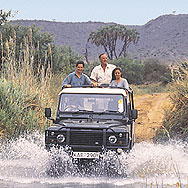
A short safari to the South of Kenya, visiting Amboseli with its excellent views of Kilimanjaro, and Tsavo West National Park. The safari ends in Mombasa from where you transfer to your hotel for a relaxing stay on the shores of the Indian Ocean.
You will stay in some of the best available lodges, situated in beautiful locations to give views out over the Savannah or surrounding countryside. Often you have the luxury of game viewing from the comfort of the lodges outdoor lounges while enjoying a cool drink. All lodges provide en-suite facilities and many have small swimming pools. Comfortable minibuses with guaranteed window seats are used on all trips and they are equipped with large roof hatches to ensure perfect game viewing and photographic conditions.
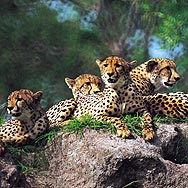
Western Kenya takes in the fertile fringes of Lake Victoria and some prime game parks. The vast, arid north-eastern region is where Kenya is at its wildest and in places almost untouched by the modern world. Kenya’s flora and fauna defies easy description. The vast plains of the south are dotted with flat-topped acacia trees, thorn bushes and the distinctive bottle-shaped Baobab tree. On the rarified slopes of Mt Elgon and Mt Kenya, bamboo forests sprout and even higher up is the bizarre groundsel tree, with its huge cabbage-like flowers, and giant lobelias with long spikes. If you are more into fur and feathers, then head for the teeming game parks. Lions, buffalos, leopards, elephants and rhinos all cavort openly in at least two of the major parks. Endangered animals such as the black rhino are slowly making a comeback and sanctuaries for these creatures can be visited in Tsavo and Lake Nakuru national parks.
Jamaica lies in the heart of the Caribbean Sea around 100 miles south of Cuba. Though just 146 miles long and 51 miles wide, the landscapes in Jamaica range from high mountains and rainforests inland, to white sandy beaches at the coast - this is a lush tropical island that has delighted visitors from afar for hundreds of years.
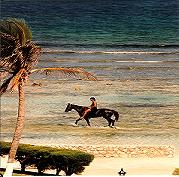
The most surprising aspect to this idyllic island is the totally relaxed pace of life. It's true that the Jamaican hotels carefree way is world-famous; it's just that it's impossible to understand just how laid-back everyone is until you've actually visited! It's a wonderful moment when you realise that this stunning island is going to live up to all your expectations.
Of course the main reason people come to Jamaica is for those breathtaking tropical beaches. All of the main resorts are on the coast, and all offer great facilities, lots of activities and friendly locals. Imagine a tropical beach scene with shallow waters, gentle waves and palm tree-fringed sands... well, that's Jamaica!
Montego Bay
Perhaps the most famous of Jamaica's resorts. Nowadays in Montego Bay you'll find mostly modern developments with an excellent range of international jamaican hotels, bars and restaurants - though you'll often turn a corner and encounter some breathtaking 18th and 19th century architecture from those turbulent historical times.
Negril
There's less bustle here than in some of Jamaica's resorts, because Negril has traditionally attracted artist and musician types. So the rural feel has been maintained, apart perhaps from modern developments at the rugged West End, where you'll find a fine selection of bars, jamaican hotels, restaurants and clubs. Beach lovers will find the Seven Mile Sands aptly named.
Ocho Rios
A well-established, purpose-built resort, right in the middle of Jamaica's north coast makes Ocho Rios a perfect base if you want to explore many of Jamaica's attractions. Added are a good range of international restaurants, low key nightlife attractions and a variety of craft markets and duty free shops.
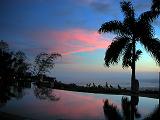
Runaway Bay
This truly relaxing resort is set on a quiet stretch of coastline, with an easy going atmosphere. There are a number of sandy beaches nearby
Falmouth
A typical Jamaican holiday guide village set on white sandy beaches with a selection of craft stalls and souvenir shops and a weekly market. Falmouth was designed by British settlers, based on the UK town of the same name.
Braco
Attracting beach lovers and sun worshippers, Braco stretches along the water's edge between Falmouth and Runaway Bay - putting both within easy reach for shopping and sightseeing. With no 'centre' as such, its sandy shoreline is hemmed by quality hotels offering varied facilities for sport and leisure. A good choice for watersports enthusiasts.
Germany offers a huge choice of regions (16 states called Bundesländer or short "Länder") most of which could provide an enjoyable and fascinating holiday. Germany is also famous for its forests, mountains and lakes.
Let�s begin for the North: Germany has coasts to the North Sea and the Baltic Sea. In this part of the country you can find the famous Fairytale Road with white, sandy beaches, resorts and seaports. There is also the city of Bremen, the Germany�s second port; there are galleries, the town hall and the Roland Statue. The Germany�s number one ocean gate way to the world is the international port of Hamburg; there are chic shops, elegant hotels and great museums. We can not forget Berlin, Germany�s capital, one of the mega cities in the world and the top travel destination in Germany. Berlin offers a wonderful combination of history, night life, architecture and culture.
In the Germany�s south you can find from the beauty of the Black Forest to the dazzling allure of the Alps. There is the city of Heidelberg, where stay the Germany�s most famous castle ruins. Other important city is Freiburg, the capital of the southern Black Forest; it is also known for its magnificent cathedral, an excellent example of late gothic architecture. There is also Munich, Bavaria�s capital and one of Germany�s most beautiful and charming cities, it is home of the world-famous Oktoberfest and of the Deutsches Museum, the largest science and industry museum in Europe. Other areas of interest in Germany�s south include Triberg, Lindau, Dinkelsbühl and the historic Franconian city of Würzburg.
In the middle, you can find Europe�s center of international business and finance: Frankfurt. The city is vibrant, dynamic, and flashy, earning it the questioning distinction of the most Americanized city in Germany. In the eastern part of Germany, you can find extraordinary cities: Leipzig, Weimar, Schwerin and even Dresden, famous for its Frauenkirche and historic center. In the western part cities still have some French influence, discover Bonn, Düsseldorf, Cologne (the heart of the Rhineland), Trier (the oldest city of Germany) or Aachen with its impressive cathedral and history back to Charlemagne.
We have to recommend the Germany�s valleys, well-known as �Romantic Wine Valleys�. Let�s begin for the Rhine Valley; its unique beauty unfurls across the legendary River Rhine. It is famous for its wine festivals during the autumn. The next romantic valley is the Moselle Valley; it attracts visitors not only for its beauty, but also for the friendly atmosphere created by wine and song. Other beautiful valleys are The Ahr Valley, the Weser valley, the Neckar valley, and the Altmühl valley.
Germany is an excellent destination all the year although its climate can be unpredictable. Most people prefer to visit it between May and September (high season) when the sunny days are most likely. A lot of activities are popular in this season, especially outdoor events (hiking, cycling and swimming) and festivals. Cold and wet weather should never be unpredicted in Germany, however: between one-third and one-half of the days each year brings some amount of precipitation. In June and July, school groups filled the major youth hostels, bringing noise and confusion.
The other seasons (from March to May and from October to early November) bring fewer tourists. Usually, in April and May the weather can be mild and sunny. On the other hand, between November and early March skies tend to be gloomy and the mercury often drops below freezing (there are only six or eight hours of daylight); in this season, travel to Germany is becoming more and more popular, especially to the ski areas in the Bavarian Alps. Keep in mind that the rain is a possibility in any month, so try to be cautious.
Visa to enter in Germany is required by all, except nationals of the following countries:
American Samoa, Andorra, Argentina, Bermuda, Bolivia, Brazil, Brunei, Chile, Colombia, Cook Islands, Costa Rica, Croatia, Cyprus, Czech Republic, Ecuador, El Salvador, Estonia, Guam, Guatemala, Honduras, Hungary, Israel, Korea (Rep. of), Latvia, Lithuania, Macau, Malaysia, Mexico, New Caledonia, New Zealand, Nicaragua, Niue, Norway, Panama, Paraguay, Poland, Singapore, Slovak Republic, Slovenia, Uruguay, Vatican City, Venezuela and US Virgin Islands. But they don�t require Visa for stays of 3 months, after this time, they must obtain a Visa.
Visa isn�t required either for passengers who continue their journey by the same or first connecting aircraft; however, it is important check with the Embassy before your trip.
Citizens of EU countries holding a valid national ID card just need a passport to enter Germany. But, if you want to take up employment, it is absolutely necessary to have a full passport.
Students
If you want to take up studies in Germany, you will need a visa for entry, but not any type of visa. You must obtain a visa for purposes of study. Documents required are: - Valid passport with one blank page to affix visa stamp.
- Application form
- Two passport photos
- Proof of sufficient funds to finance your period of study
- Fee (payable in cash or by postal order)
- Letter from the place of study (University, college or school)
Tourists
If you are not a citizen of EU countries or of any country mentioned before, you must obtain a tourist visa. Documents necessaries are:
- Valid passport with one blank page to affix visa stamp.
- Application form
- Three photos
- Proof of adequate means of support during stay (at least £20.00 per day).
- Proof of medical insurance.
- Proof of accommodation
- Fee (payable in cash or by postal order)
Business
If you have to enter to Germany for any business purpose, even if you are self employed, you need a visa. Documents necessaries to obtain a Business Visa are: - Valid passport with one blank page to affix visa stamp
- Letter from the employer or place to work, if self employed, a letter from a solicitor, accountant, bank manager or local Chamber of Commerce
- Formal obligation from host in Germany
- Fee (payable in cash or by postal order)
Work permits
Currently, citizens of EU countries don�t need a visa or work permit to work in Germany. But non-EU nationals must obtain a visa or resident permit before entering Germany. Documents required to obtain a work visa are:
- Valid passport with one blank page to affix visa stamp
- Two application forms
- Two passport photographs
- Employment contract or a letter from your future employer in Germany (with a copy)
- Police certificate of good conduct
- Fee (payable in cash or by postal order)
Validity of Visa
Visa is valid according your stay type, and it can not be extended. If you want to stay more time, you have to make a new application.
Short stay (single and multiple entry): Valid for 6 months from date of issue for stays of maximum 90 days per entry or for 1 year from date of entry for stays of maximum 90 days in one half-year.
Transit (single and multiple entry): Valid for a maximum of 5 days per entry, including the day of arrival.

STUTTGART is the capital of the Baden-Württemberg state and is located in the center of the populated southwestern of Germany. Stuttgart is an ideal starting point for excursions to the Black Forest, the Swabian Alb, the Lake of Constance, the Hohenloher Land as well as the neighboring countries of Austria, France and Switzerland. Stuttgart is a cosmopolitan area and it is one of the prominent and well-known German towns, particularly due to its cultural, administrative and huge economic importance.
Stuttgart was chartered in the 13th cent and it became a residence of the counts of Württemberg, who made it their capital at the end of the 15th cent. After World War I it became famous for its numerous modern buildings with an innovative architecture. In World War II, the center of the city was almost totally destroyed although after 1945 many old buildings were restored.
Stuttgart is a relaxing city, its wonderful environment including the black forest and lots of acres of vineyards which make it one of the greenest cities in Europe. The region's long wine-growing tradition is carefully documented in a museum. Even as visitors come in to land at Stuttgart International Airport, they will be impressed by a fascinating landscape consisting of mountains, woods, vineyards, gardens, meadows and fields.
In Stuttgart, you can find a lot for the whole family: museums, art galleries, beautiful squares and imposing palaces. There are also exclusive stores, boutiques, modern malls and street cafés � some extravagant, other more elegant � that offer a beautiful view of the city.
The city is the place where the motorbike and the four-wheeled automobile were invented, famous and prestigious brands as Mercedes-Benz and Porsche are produced there. One of the Stuttgart�s attractions is the Mercedes Benz museum that is one of the best visited museums.
BERLIN is the largest city in Germany and it is best known for its historical associations as the German capital. It offers a wonderful combination of history, night life, architecture and culture. Berlin has modest beginnings, but over time it grew into a European powerhouse and since reunification in 1990 it became into a dynamic and creative city.
Berlin has wonderful sights although it is not as centralized or small as other European cities. It is also known as one of the greenest cities in Europe: over 60% of its surface area is either a park or a river, it is beautiful! Berlin is also an industrial city; key industries such as electronics, manufacturing and information technology reflect the hopes for a brighter future for the city.
In Berlin, you will find the leisure time activities that you would find in every big city all over the world, and in the city limits there are numerous recreational areas, nature reserves and parks. You can find a lot of amazing things simply strolling along one of its fascinating streets. Berlin is a city that thrives on change and that has made a virtue out of reinventing itself s one of Europe�s finest capitals.
FRANKFURT AM MAIN is called �the Manhattan of Germany� because of its location on the Main river. The city is the financial heart not only of Germany but also of the European Union, pumping euros into the world economy. Frankfurt is a dynamic metropolis and for many visitors it will be the first point of call in Europe, because its airport is the largest in terms of passengers on the European continent.
During World War II Frankfurt was deeply bombed, and as consequence, its medieval city was destroyed. Happily, the city recovered quite quickly after the war, and its modern shape was formed. With the rebuilding process, one of the Europe�s most efficient underground transportation systems was developed. That system includes a subway train system (S-Bahn) and a deep subway with smaller coaches (U-Bahn). Frankfurt also contains the tallest skyscraper in the European Union, the Commerzbank Tower, which is also the second tallest on the continent (after the Triumph-Palace building in Moscow).
Frankfurt is frequently seen only as a transit hub or a business centre, but it is so much more. In fact, it is a prosperous cultural centre for the entire Hesse, with a good collection of theatres, galleries, museums, amongst them some architectural highlights. While Frankfurt is not the size of London or Paris, it will not keep you wanting in terms of cultural activities.
Frankfurt is a city with two faces: On the first it is the competitive financial capital of Germany and on the other it is a civilized place which spends more on the arts than any other city in Europe. If you have more time to spend, Frankfurt is a perfect starting point for daytrips up the Rhine River towards Rudesheim or Heidelberg and only a 30 minutes train trip away from Wiesbaden, Mainz or Marburg.








